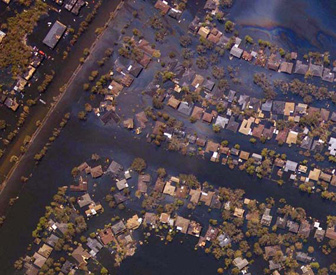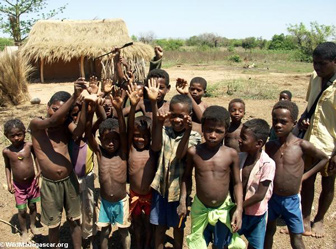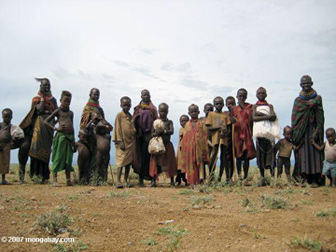Ecomigration: global warming will increase environmental refugees
Ecomigration: global warming will increase environmental refugees
mongabay.com
November 28, 2007
Climate change could spawn the largest-ever migration of environmental refugees due to intensifying droughts, storms and floods, according to a new study published in Human Ecology.
“People facing environmental disasters have no choice but to leave the affected area,” states a release from Springer, publisher of Human Ecology. “The larger the migration and the shorter the period over which it occurs, the harder it is to absorb the migrants, raising the likelihood of conflict.”
Analyzing three case studies — the US Dust Bowl in the 1930s; Bangladesh since the 1950s; and Hurricane Katrina in 2005 — Indiana University professor Rafael Reuveny found that while “climate change can spur large population movements, public policy can alleviate the pressures of ecomigration.”
“Environmental migrants and residents of the area absorbing them may clash over jobs, resources and way of life, and violent interactions such as theft, beating, armed scuffles, seizure of resources and property, murders, insurgencies, and organized militarized violence are possible and, to the extent that history can tell us something about the future, perhaps even likely,” Reuveny told mongabay.com.
Reuveny says that investments in preventive strategies in areas at risk of environmental problems could help reduce the need to migrate as well at mitigate conflicts in areas receiving migrants.
“Minimizing climate change-induced migration and violent conflict in receiving areas requires an engineered economic slowdown in the developed countries, and population stabilization and economic growth in developing countries financed by the developed countries,” writes Reuveny.
Commentary from Rafael Reuveny, author of the Human Ecology article
Scholars generally expect that climate change will have costly effects, assuming no mitigation. The extent of the damages is not fully known, but we know that mitigating climate change is costly. In this light, it seems two policies are possible: “wait and see,”or act sooner, assuming things might get worse. Let us evaluate which of these policies to pursue in the context of migration and conflict.

The aftermath of Hurricane Katrina in New Orleans Photo courtesy of NOAA |
We all typically employ historical data for similar circumstances in order to learn about the operating forces and the ability of policies to deal with them. While it is important to be careful when using history as a basis for policy analysis, it is generally assumed that historical data may inform us about the future, ceteris paribus. I demonstrated in my article the operation of the forces of environmental migration and conflict in three cases, involving out-migrations from the US Great Plains to other parts of the US (particularly the West Coast) in the 1930s, from Bangladesh to India and within Bangladesh since the 1950s, and from Louisiana and Mississippi to other parts of the US (particularly to adjacent states such as Texas) in 2005.
Logically, since environmental degradation led to migration and conflict in the three cases I have examined, climate change-induced environmental degradation may also do so, assuming no mitigation measures are taken. My analysis suggests that climate change may spur large population movements. Yet it also demonstrates that public policy can alleviate pressures of environmental migration. Which public policy approach, then, should we take in order to minimize climate change-induced migration and conflict?
As I show and fully document in my article, today many migrants move from one less developed country (LDC) to another and almost all internally displaced people are in LDCs, but existing data and estimates suggest that if given a choice, migrants from LDCs will probably choose to relocate to DCs. For example, since 1986 about 400,000 new immigrants legally entered the US each year, and 500,000-1,000,000 foreigners each year changed their status from illegal or temporary visa to legal permanent resident; about 90% of these people are from LDCs. About 1.1-1.8 million aliens were deported from the US each year since 1996, almost all of which are from LDCs. It is estimated that since 2000 about 850,000 people successfully enter the US illegally each year, and 500,000 do so in Western Europe. Almost all of these migrants are from LDCs.

Africa is expected to bear the brunt of climate change despite contributing the least to the problem. |
Facing growing immigration pressures, the developed countries (DCs) have intensified restrictions on legal immigration from the LDCs since the 1990s; in 2006 the US began building fences along its border with Mexico. Is this the appropriate approach to deal with environmental migration? In considering this question, it is useful to recall Garrett Hardin’s life-boat metaphor. Rich people live on a few fully-equipped and relatively empty lifeboats (the DCs, many of which are not densely populated, e.g., the US). Poor people live on many partially-equipped lifeboats filled to capacity (the LDCs, many of which are densely populated, e.g., Bangladesh). The rich boats face three choices: admit all the poor people, admit some poor people, or reject everyone. If they were to admit everyone, they would sink, that is, the DCs could not absorb hundreds of millions of migrants from the LDCs that may eventually attain the standard of living in the DCs. If they were to admit some people, who should be excluded? If they were to reject everyone, they might face unwieldy pressures. The poor people also face three choices: move from one poor boat to another (move between LDCs), change places inside their boat (move within LDCs), or sneak onto a rich boat (enter DCs illegally).

Changes in precipitation could cause problems for the nomadic Turkana people in Kenya. Migration into Sudan and other parts of Kenya could well produce conflict over resources with other ethnic groups. |
This metaphor has essentially been ignored by DCs. This is awkward, since the movement of people across and within boats can promote inter-boat conflict. As discussed, the LDCs will likely experience more climate change-induced migration and conflict than DCs, but the fallout may expand beyond LDCs. Large-scale ecomigration could increase international tensions, perhaps instigating terrorism recruitment. For example, as climate change progresses, many people may be driven from China’s inundated coastal zones. China might then demand compensation, arguing that while it is the second (or even the first, in the longer run) driver of climate change, the US has historically been by far the leading driver of climate change and its per capita contribution to the problem is much larger than that of China. The US, China might argue, should pay for at least some, if not most, of the damages. Environmental migration-induced conflict could also upset the political stability of the allies of DCs in the developing world, drawing DC into the fight. Of course, environmental migration due to climate change does not have to lead to conflict, and localized conflicts generally may not spread. However, history suggests that these possibilities cannot be overruled.
All this shows the need for public policy. In fact, public policy might save the day as it did in the US in the 1930s or since late 2005. But the problem LDCs face differs crucially from the ones the US has faced; LDCs can hardly adapt to climate change-driven environmental calamities on their own, but DCs tend to ignore this fact. While this approach is ethically dubious, as the DCs are the chief source of the greenhouse emissions that cause climate change, the issue goes beyond ethics. Historically, extreme income inequalities, such as the one between DCs and LDCs, led to violence (e.g., the French or Russian Revolutions). The current situation is more dangerous, since some LDCs have, or try to obtain, weapons of mass destruction. Add to that grievances over environmental or ecomigration and you get a volatile situation.
Economic growth in LDCs may solve the problem, lowering the dependence of LDCs on the environment for livelihood and funding expansion of environmental regulation and cleanups. However, growth in LDCs will also raise their demand for energy and, given the current technology, accelerate climate change. In response to this dilemma, I advocate a 5-part approach:
- Stimulate economic growth in LDCs in order to reduce their dependence on the environment and enable investment in development and enforcement of environmental regulations and cleanup plan;
- Promote lower population growth in LDCs in order to reduce the pressure on the environment;
- Offset economic growth in LDCs with contraction in DCs, keeping the rise in greenhouse gasses in check;
- Begin adapting for climate change now in places prone to conflict and ecomigration; and
- Fund these activities by using DCs funds, since the DCs over-reliance on fossil fuels created most of the current problem. This step could be achieved, for example, by raising taxes in DCs and investing the revenues in LDCs.
Naturally, the implementation of this plan may not be easy. Since socioeconomic-ecological processes can be slow, the benefits of these five steps may take time to show up. There also may be problems of international collective action, as countries try to shift their own burdens of adjustment to others. These difficult issues require separate analyses.
To be sure, humanity will probably continue to muddle around for some time and stress on the biosphere will rise. My plan might be ultimately initiated in response to some massive crisis, but a crisis also might cause large, irreversible damages. While human ingenuity may yet save the day, it seems that our best reason for optimism is the fact that in the past, humans found solutions to some large problems. One cannot know if this pattern will continue. In the end, then, whether DCs accept my plan depends on their attitude toward risk. While exact figures are not available, I believe the expected cost of climate change-induced migration and conflict will likely rise quickly, assuming no mitigation. This supports adoption of my plan sooner, rather than later. As the saying goes, it is better to be safe than sorry.